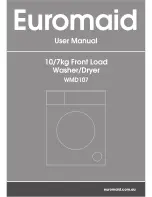
30
SPOTS AND STAINS ON DISHES
PROBLEM
POSSIBLE CAUSE
SOLUTION
Spotting and filming
on dishes
NOTE: To remove
spots and film from
dishes. Try a white
vinegar rinse. This
procedure is intended
for occasional use
only. Vinegar is an
acid and using it too
often could damage
your dishwasher. See
“Cleaning .”
Hard water. High mineral
content in your water
Use a rinse aid and keep
the dispenser filled to
help eliminate spotting
and filming.
If your water
hardness is 13 grains
or above, it is strongly
recommended that you
install a home water
softener.
Water temperature is too
low.
For best results, water
should be a minimum 120°F
(49°C) as it enters the
dishwasher.
Did not use enough
detergent.
Use a minimum of 1 Tbsp.
(15 g) of detergent per
load.
Heavy soil and/or hard
water generally require extra
detergent.
Detergent is too old.
Detergent must be fresh
and dry to be effective.
Store
detergent in a cool, dry area.
Home water pressure is
too low to fill dishwasher
properly.
Water pressure to the home
should be 20 to 120 psi
(138 to 828 kPa) for proper
dishwasher fill. A booster
pump on the water supply
can be added if pressure is
too low.
Rinse aid dispenser is
empty.
Add rinse aid to the
dispenser.
Silica film or etching
Sometimes there is a
water/chemical reaction
with certain types
of glassware. This is
usually caused by some
combination of softened
water, alkaline washing
solutions, insufficient
rinsing, overloading the
dishwasher, and the heat
of drying.
Silica film and etching are
permanent and cannot
be removed.
To slow this
process, use a minimum
amount of detergent
but not less than 1
tbsp.
(15 g) per load. Use a liquid
rinse aid and under load
the dishwasher to allow
thorough rinsing. Do not use
heated drying.
The inlet water
temperature exceeds
150°F (65°”C).
Lower the incoming water
temperature.
















































